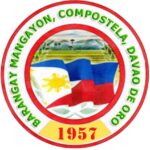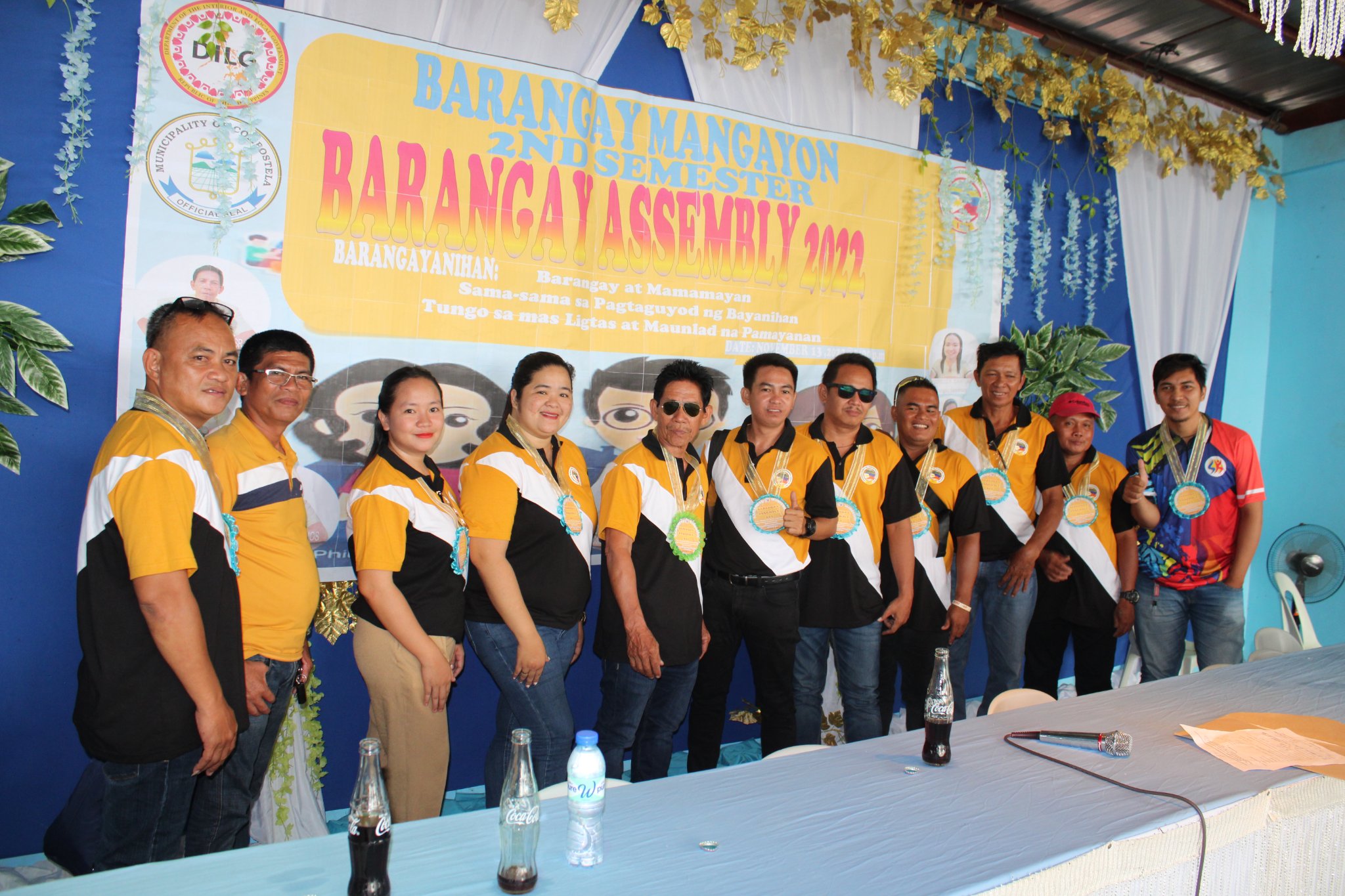BARANGAY MANGAYON
The name Mangayon was taken from a “MAYGAYON CREEK” in native language of the mandayas. Before world war II, the pioneering natives are the mandayas pasthe Maygayon creek wading their feet on it every time they brought their farm products to town of Compostela. thus the place was named Mangayon.

In the middle of 1930’s migrants from Visayas arrived namely Catalino Getubig and family, Candido Abarquez Sr. , Primitivo P. Eyas, Emeteria Abarquez, Constancio Eyas, Saturnino Eyas, Inosaria Abarquez , Juanito Regana and family, Pre war-time there were already Japanese families planting ramie at Reganas area. They utilized Agusan River as their transportation area using Bangka to load their products. Before the war broke there were people arrived to seek greener pasture and maybe to escape from the coming war between the Japanese and Americans, namely Fuentes family, and other .
The war begun on 1940 and end on 1945. Liberation time the government surveyed the area and the people who were here occupied the area cutting the small trees to plant abaca as it was the main products of that time.
On June 23, 1957, under Republic Act No. 2039, the place was created into barrio under the municipality of Compostela.
And on the year 1989 the Ata Manobo Tribe arrived and settled at the upper part of the barangay which was called as Side 4 , Bermuda, Purok 4-B, Mangayon coming from San Fernando, Bukidnon and Talaingod, Davao del Norte.

The first appointed teniente del barrio was Candido M. Abarquez followed by Santiago Sejuela then by Arsenio Pely. He was followed by Antonio Allonar then by Claro Fuentes, and Ruperto Magno. He was followed by Leopoldo Abarquez then by Marcelo . Dalagan . then by Jose Villanueva Jr. On 2007 Barangay election, Ramon A. Eyas was elected as Barangay captain and still the present barangay captain .
The first school was established in 1950 made of cogon and round timber offering multi-grade with only one teacher. In 1960, additional three (3) teachers taught in the school. At present, there is a complete elementary in the place with the help of the Parents – Teachers Association (PTA), by the barangay and by the municipal officials.
Its population as determined by the 2020 Census was 4,877. This represented 5.43% of the total population of Compostela.
Demographics
Households
The household population of Mangayon in the 2015 Census was 4,678 broken down into 1,095 households or an average of 4.27 members per household.
details
| Census date | Household population | Number of households | Average household size |
|---|---|---|---|
| 3,032 | 533 | 5.69 | |
| 2,630 | 485 | 5.42 | |
| 3,324 | 639 | 5.20 | |
| 4,062 | 807 | 5.03 | |
| 4,403 | 933 | 4.72 | |
| 4,678 | 1,095 | 4.27 |
Population by age group
According to the 2015 Census, the age group with the highest population in Mangayon is 5 to 9, with 574 individuals. Conversely, the age group with the lowest population is 80 and over, with 26 individuals.
Combining age groups together, those aged 14 and below, consisting of the young dependent population which include infants/babies, children and young adolescents/teenagers, make up an aggregate of 35.63% (1,667). Those aged 15 up to 64, roughly, the economically active population and actual or potential members of the work force, constitute a total of 60.88% (2,848). Finally, old dependent population consisting of the senior citizens, those aged 65 and over, total 3.48% (163) in all.
The computed Age Dependency Ratios mean that among the population of Mangayon, there are 59 youth dependents to every 100 of the working age population; there are 6 aged/senior citizens to every 100 of the working population; and overall, there are 64 dependents (young and old-age) to every 100 of the working population.
The median age of 23 indicates that half of the entire population of Mangayon are aged less than 23 and the other half are over the age of 23.
| Age group | Population (2015) | Age group percentage |
|---|---|---|
| Under 1 | 94 | 2.01% |
| 1 to 4 | 437 | 9.34% |
| 5 to 9 | 574 | 12.27% |
| 10 to 14 | 562 | 12.01% |
| 15 to 19 | 432 | 9.23% |
| 20 to 24 | 442 | 9.45% |
| 25 to 29 | 390 | 8.34% |
| 30 to 34 | 340 | 7.27% |
| 35 to 39 | 268 | 5.73% |
| 40 to 44 | 281 | 6.01% |
| 45 to 49 | 220 | 4.70% |
| 50 to 54 | 183 | 3.91% |
| 55 to 59 | 161 | 3.44% |
| 60 to 64 | 131 | 2.80% |
| 65 to 69 | 62 | 1.33% |
| 70 to 74 | 40 | 0.86% |
| 75 to 79 | 35 | 0.75% |
| 80 and over | 26 | 0.56% |
| Total | 4,678 | 100.00% |
|
||
Historical population
The population of Mangayon grew from 3,032 in 1990 to 4,877 in 2020, an increase of 1,845 people over the course of 30 years. The latest census figures in 2020 denote a positive growth rate of 0.88%, or an increase of 199 people, from the previous population of 4,678 in 2015.
| Census date | Population | Growth rate |
|---|---|---|
| 3,032 | – | |
| 2,630 | -2.63% | |
| 3,324 | 5.15% | |
| 4,062 | 2.80% | |
| 4,403 | 2.98% | |
| 4,678 | 1.16% | |
| 4,877 | 0.88% |
Mangayon is situated at approximately 7.7158, 126.1043, in the island of Mindanao. Elevation at these coordinates is estimated at 72.2 meters or 236.9 feet above mean sea level.






Adjacent barangays
Mangayon shares a common border with the following barangay(s):
- Abijod, Cateel, Davao Oriental
- Naboc, Monkayo, Davao de Oro
- Panansalan, Compostela, Davao de Oro
- Mapaca, Compostela, Davao de Oro
- Babag, Monkayo, Davao de Oro
- Bagongon, Compostela, Davao de Oro
- Tamia, Compostela, Davao de Oro
- San Vicente, Cateel, Davao Oriental
- Tubo-tubo (New Del Monte), Monkayo, Davao de Oro
- Mount Diwata, Monkayo, Davao de Oro
